The arrival of fall brings shorter days, cooler nights and a gradual winding down of garden activity. Flowers start to fade, while leaves turn glorious colors and begin to fall from the trees. For many gardeners, though, fall isn't a time to relax and put their feet up. That's because common garden advice tells us to rake up all those leaves, remove every dried stalk and maybe even begin a burn pile for branches and twigs pruned at this time of year.
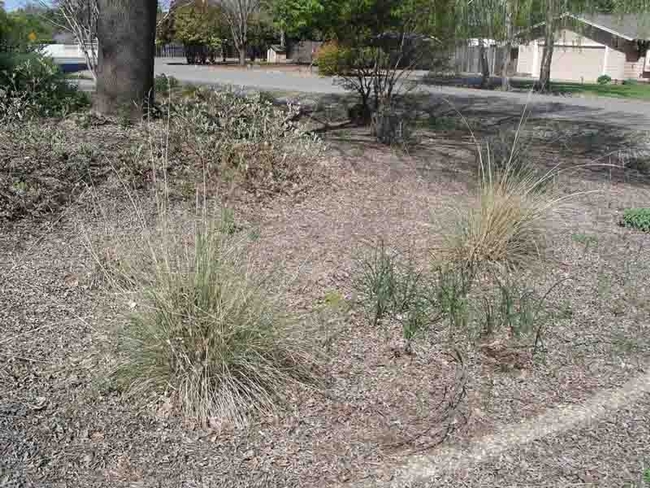
Allowing the leaves to break down over the fall and winter months is a form of natural composting that adds back nutrients, increases soil tilth and feeds organisms necessary for healthy plants. In the prolonged drought we are experiencing, a layer of leaves helps to retain moisture. And invertebrates that help control garden pests depend on leafy ground for shelter and survival over the winter.
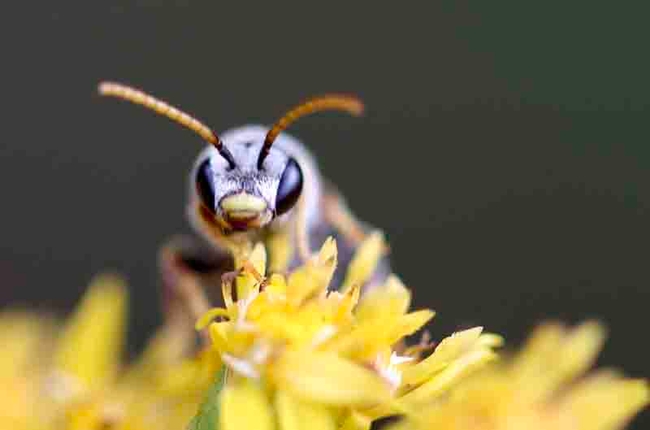
In addition to letting leaves compost naturally, there is another reason to do less clean up in our fall gardens. A very important group of invertebrates that benefit from and depend upon these garden “leftovers” are our native bees. Most people think immediately of bumblebees and honeybees when the subject of bees comes up. But in fact California is home to 1600 species of native bees of various sizes, shapes, and colors, and all of them are important pollinators of flowering plants, shrubs and trees. Some are even considered essential crop pollinators for orchards and commercially-grown produce like tomatoes.
We are able to benefit in myriad ways from the huge diversity and beauty of flowering plants and the bounty of vegetables because of pollinators, especially bees. Bees and flowers evolved together, with flowers producing pollen and nectar needed for food at various life stages by all bees (they are vegetarians, whereas their wasp cousins are carnivorous). Bees help move pollen from one flowering plant to another, thus ensuring the plants' successful reproduction.
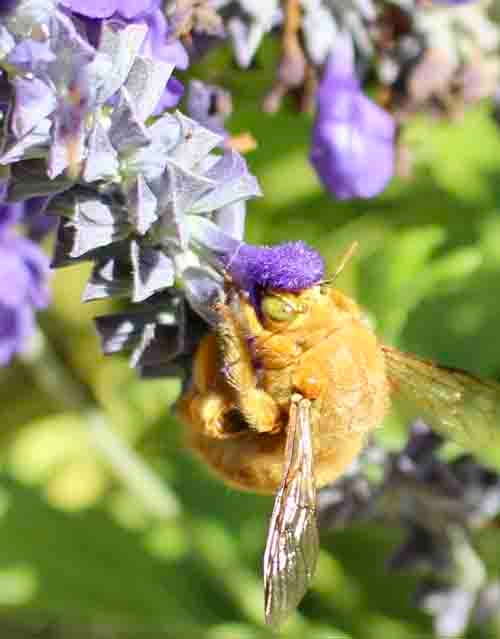
When we allow some leaves to break down naturally in our fall gardens, we are helping to provide nesting sites and shelter for native bees so they can survive the winter and emerge in spring to start a new generation.
Almost all native bees are solitary; after mating the female does the work of building and provisioning a nest and then lays her eggs. There are no queens or worker bees and most do not tend to the young, leaving them to complete their development into a new adult bee on their own. The majority of native bees have fairly brief life spans as active adult bees, often only living a few weeks or months.
Bumblebees, however, are social. They form nests with a queen and worker bees but unlike honeybees (which are not native to North America, and were introduced in the 1600s) the nest only survives one year with a newly mated queen flying off in the fall and finding someplace, often in the ground, to overwinter before emerging in spring to start a new nest.
Different native bee species emerge throughout the spring, summer and fall, often appearing when the flowers they depend on are blooming. Our native manzanitas, California lilac and Western redbud, which bloom in early spring, are good examples of this seasonality. The associated bee visitors emerge from their winter nests and show up in our gardens around the same time these natives are blooming. Our home gardens can provide native bees with flowers for sustenance and places to nest.
Our native bees have common names that can give a clue to the type of nest they build or a behavior they share. Carpenter bees chew into wood or stems to form their nests. Leafcutters cut circles or ovals from soft leaves that they then use in a stem or tunnel for nest building. Mason bees use mud to partition their nests. Cellophane bees make a resinous gel to form their cells. Sweat bees like to drink in the perspiration on exposed skin!

A good example of a stem nester that depends on dried stems or stalks is Ceratina, the small carpenter bee. She uses these pithy stems to build her nest, lay her eggs and overwinter as an adult bee. Flowering perennials that have long, fairly strong stalks with a softer or pithy interior are Ceratina's choice for nesting.
Leaving dried stalks on the ground instead of removing them provides opportunities for these nests. Come spring, the female, after mating with a male bee, starts chewing from the top of the stalk or sometimes through the side to form a tunnel. She gathers a pollen and nectar ball and provisions this tunnel, laying her egg on top of the food source. She then seals this into a cell and builds another. Usually, five to six cells are formed in each tunnel. Ceratina is a bit unusual as she doesn't close the top of the nest and will guard it from predators. The next generation develops into adults and spends the winter inside the nest tunnel, emerging in spring to start the cycle again.
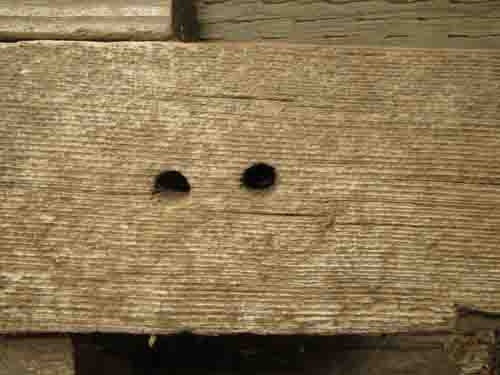
Not cutting down dried stalks in the fall could mean saving a nest and allowing it to overwinter. Waiting until early spring to cut the seed heads off will open up the stalks and hopefully allow newly emerging females a nesting place. You can watch these cut stems for any activity! Most of our native bees will go about their business with no regard to us. They are a fascinating and often beautiful group of insects, mostly unwilling or even unable to sting. They go about their lives harmlessly and often unnoticed, unless we take the time and effort to look for them.
The past year's stubble with old nests will quickly decompose through spring and new perennial growth will hide much of it. Additionally, letting dried seed heads remain often provides benefits to birds and other wildlife that eat the seeds. When and where feasible, leaving stumps of trees or piles of brush in place can also provide nesting sites for tunnel nesters and other winter hibernators.
Ground-nesting bees need areas of bare soil or ground that is lightly mulched or covered with a thin layer of leaves. They tunnel down to build their nests, also with chambers and cells, provisioning them and laying their eggs. They too need these nest sites to survive winter. Not tilling the soil if possible and avoiding pesticides helps them nest successfully. Pesticides are problematic as these bees use their mouths to excavate the soil, putting them in contact with any pesticides present in the dirt near their nests.
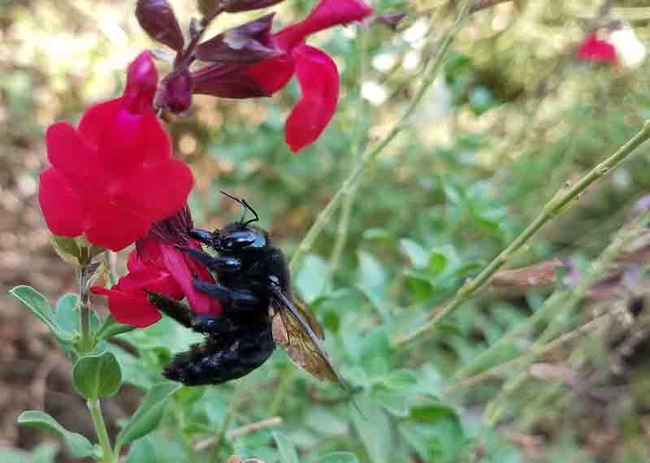
Making some or all of these small, but potentially significant changes to our gardening habits (and aesthetics) each fall has the potential to encourage the population growth of these important insects while, at the same time, increasing the health of the soil in our gardens. Tell your friends and neighbors that you're “leaving some leaves,” and stems, for the benefit of healthier plants and for the sustenance of wildlife, including our very important pollinators -- native bees.
UC Master Gardeners of Butte County are part of the University of California Cooperative Extension (UCCE) system. To learn more about us and our upcoming events, and for help with gardening in our area, visit our website. If you have a gardening question or problem, email the Hotline at mgbutte@ucanr.edu or leave a phone message on our Hotline at (530) 538-7201. To speak to a Master Gardener about a gardening issue, or to drop by the MG office during Hotline hours, see the most current information on our Ask Us Hotline webpage.